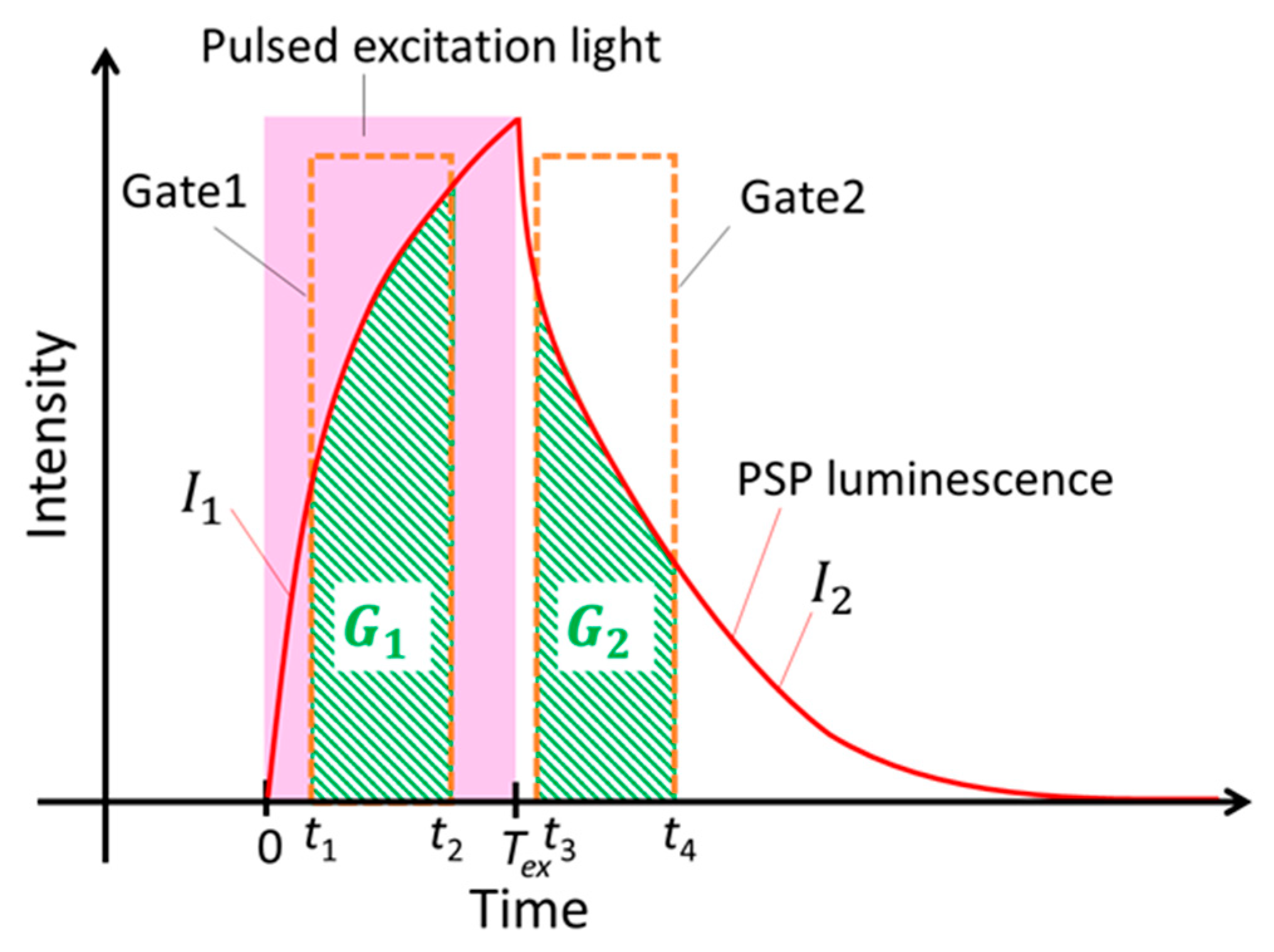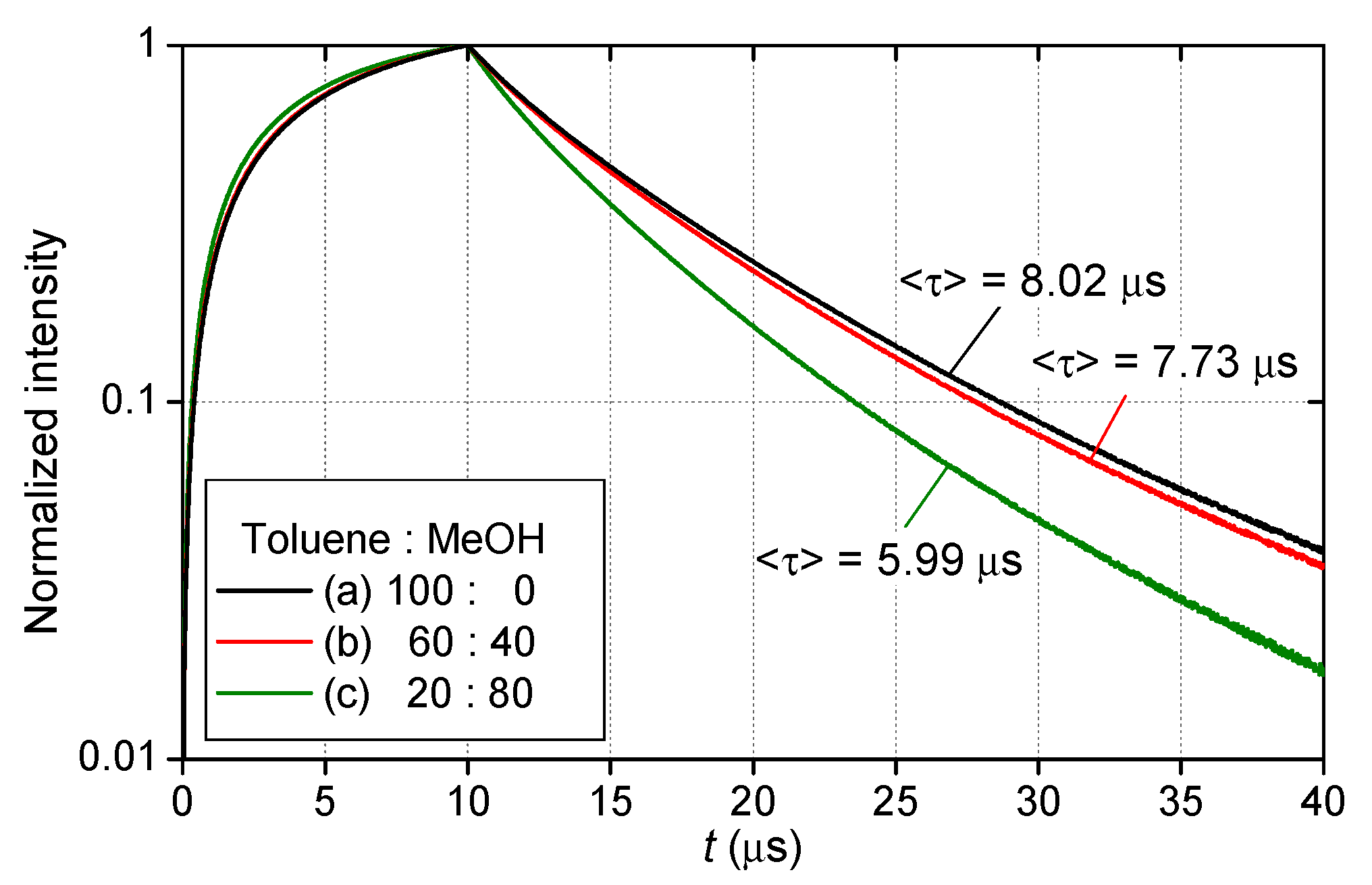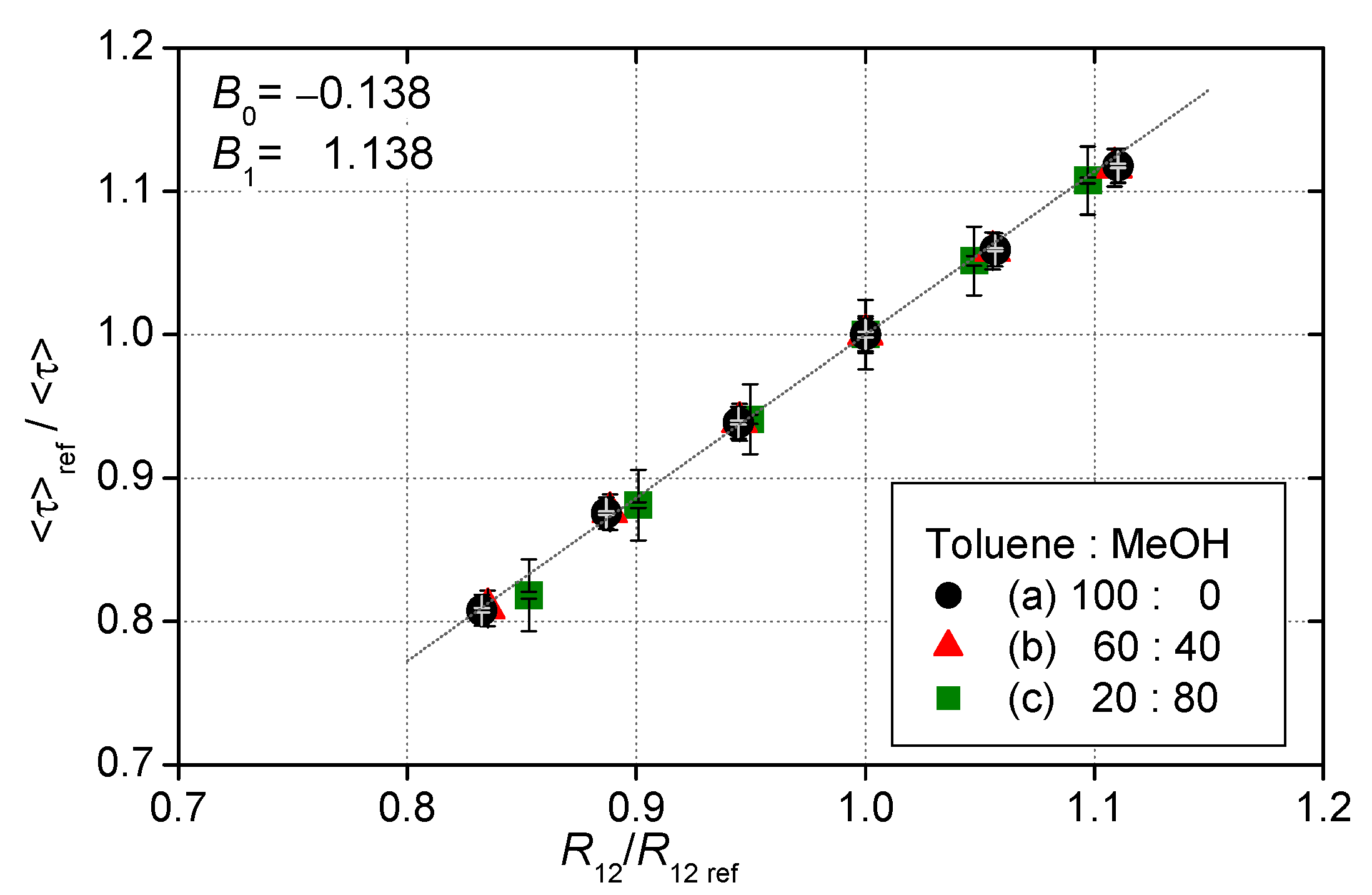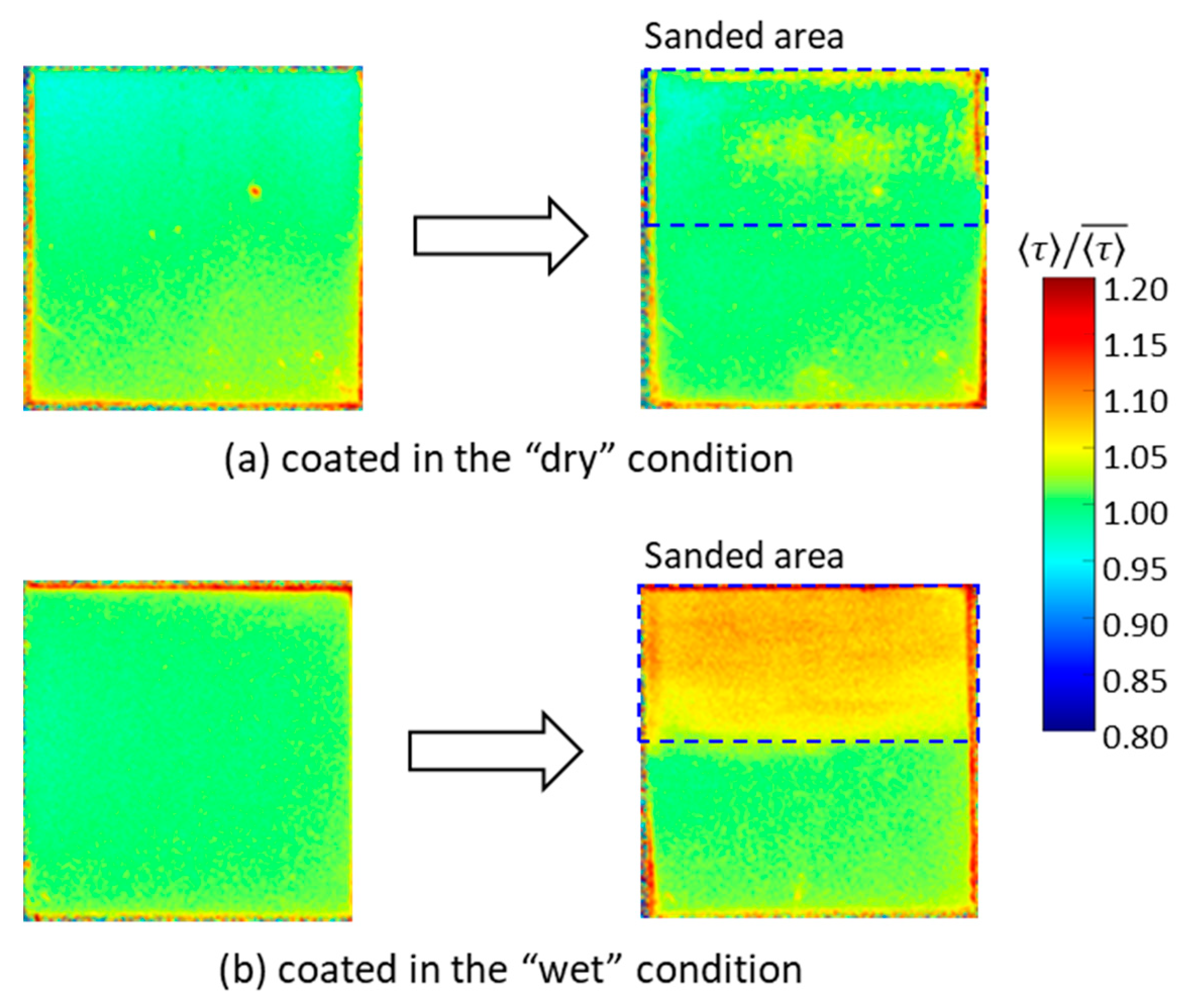Investigation of Factors Causing Nonuniformity in Luminescence Lifetime of Fast-Responding Pressure-Sensitive Paints
Abstract
:1. Introduction
2. Lifetime Imaging Method and PSP Characteristics
3. Experimental Methods
3.1. Materials and Preparation
3.1.1. One-Component Fast-PSP (1C-PSP)
3.1.2. Two-Component Fast-PSP (2C-PSP)
3.1.3. Polymer-Based PSP
3.2. Luminescence Lifetime Measurement
4. Results and Discussion
4.1. Effect of Luminophore Solvents on 2C-PSP
4.2. Effect of Luminophore Amount Applied
4.3. Effect of Thickness of the Binder Layer
4.4. Depth Variation of Luminescence Lifetime
4.5. Luminescence Lifetime for Large Samples
5. Conclusions
Author Contributions
Funding
Institutional Review Board Statement
Informed Consent Statement
Data Availability Statement
Acknowledgments
Conflicts of Interest
References
- Liu, T.; Sullivan, J.P. Pressure and Temperature Sensitive Paints; Springer: Berlin/Heidelberg, Germany, 2005; ISBN 978-3-540-26644-0. [Google Scholar]
- Ponomarev, S.; Gouterman, M. Fast responding pressure sensitive paints based on high concentration of hard particles in polymer. In Proceedings of the 6th Annual Pressure-Sensitive Paint Workshop, The Boeing Co., Seattle, WA, USA, 6–8 October 1998; p. 31. [Google Scholar]
- Scroggin, A.; Slamovich, E.; Crafton, J.; Lachendro, N.; Sullivan, J. Porous polymer/ceramic composites for luminescence-based temperature and pressure measurement. MRS Online Proc. Libr. Arch. 1999, 560, 347–352. [Google Scholar] [CrossRef]
- Gregory, J.; Sakaue, H.; Sullivan, J. Unsteady pressure measurements in turbomachinery using porous pressure sensitive paint. In Proceedings of the 40th AIAA Aerospace Sciences Meeting & Exhibit, Reno, NV, USA, 14–17 June 2002; p. 84. [Google Scholar] [CrossRef]
- Gregory, J.W.; Sakaue, H.; Liu, T.; Sullivan, J.P. Fast pressure-sensitive paint for flow and acoustic diagnostics. Annu. Rev. Fluid Mech. 2014, 46, 303–330. [Google Scholar] [CrossRef]
- Holmes, J.W. Analysis of radiometric, lifetime and fluorescent lifetime imaging for pressure sensitive paint. Aeronaut. J. 1998, 102, 189–194. [Google Scholar] [CrossRef]
- Sellers, M.E. Application of pressure sensitive paint for determining aerodynamic loads on a scale model of the F-16C. In Proceedings of the 21st Aerodynamic Measurement Technology and Ground Testing Conference, Denver, CO, USA, 19–22 June 2000; p. 2528. [Google Scholar] [CrossRef]
- Watkins, A.N.; Jordan, J.D.; Leighty, B.D.; Ingram, J.L.; Oglesby, D.M. Development of next generation lifetime PSP imaging system. In Proceedings of the ICIASF 2003 Record, 20th International Congress on Instrumentation in Aerospace Simulation Facilities, Gottingen, Germany, 25–29 August 2003; pp. 372–382. [Google Scholar]
- Sellers, M.E. Advances in AEDC’s lifetime pressure-sensitive paint program. In Proceedings of the U.S. Air Force T&E Days Conferences, Nashville, TN, USA, 6–8 December 2005; p. 7638. [Google Scholar] [CrossRef]
- Mitsuo, K.; Asai, K.; Suzuki, H.; Mizushima, H. Three-gate lifetime imaging system for pressure-sensitive paint measurements. AIAA J. 2006, 44, 600–607. [Google Scholar] [CrossRef]
- Mitsuo, K.; Asai, K.; Takahashi, A.; Mizushima, H. Advanced lifetime PSP imaging system for pressure and temperature field measurement. Meas. Sci. Technol. 2006, 17, 1282–1291. [Google Scholar] [CrossRef]
- Sugioka, Y.; Nakakita, K.; Satoh, K.; Nonomura, T.; Asai, K. First results of lifetime-based unsteady PSP measurement on a pitching airfoil in transonic flow. In Proceedings of the 2018 AIAA Aerospace Sciences Meeting, Kissimmee, FL, USA, 8–12 January 2018; p. 1030. [Google Scholar] [CrossRef]
- Sugioka, Y.; Sato, H.; Nakakita, K.; Nakajima, T.; Nonomura, T.; Asai, K. In-Flight visualization of shock wave on a jet aircraft wing using lifetime-based pressure-sensitive paint technique. In Proceedings of the AIAA SciTech 2019 Forum, San Diego, CA, USA, 7–11 January 2019; p. 24. [Google Scholar] [CrossRef]
- Yorita, D.; Henne, U.; Klein, C. Improvement of lifetime-based PSP technique for industrial wind tunnel tests. In Proceedings of the 55th AIAA Aerospace Sciences Meeting, Grapevine, TX, USA, 9–13 January 2017; p. 703. [Google Scholar] [CrossRef]
- Yorita, D.; Henne, U.; Klein, C.; Munekata, M.; Holst, G.A. Investigation of image-based lifetime PSP measurements with sinusoidal excitation light. In Proceedings of the AIAA SciTech 2019 Forum, San Diego, CA, USA, 7–11 January 2019; p. 23. [Google Scholar] [CrossRef] [Green Version]
- Ryuten, W.; Sellers, M.; Baker, W. Spatially nonuniform self-quenching of the pressure-Sensitive Paint PtTFPP/FIB. In Proceedings of the 47th AIAA Aerospace Sciences Meeting including the New Horizons Forum and Aerospace Exposition, Orlando, FL, USA, 5–8 June 2009; p. 1660. [Google Scholar] [CrossRef]
- Weiss, A.; Geisler, R.; Schwermer, T.; Klein, C.; Raffel, M. Single-shot pressure-sensitive paint lifetime measurements on fast rotating blades using an optimized double-shutter technique. Exp. Fluids 2017, 58, 120. [Google Scholar] [CrossRef] [Green Version]
- Egami, Y.; Konishi, S.; Sato, Y. Development of sprayable pressure-sensitive paint with a response time of less than 10 µs. AIAA J. 2019, 57, 2198–2203. [Google Scholar] [CrossRef]
- Egami, Y.; Hasegawa, A.; Matsuda, Y.; Ikami, T.; Nagai, H. Ruthenium-based fast-responding pressure-sensitive paint for measuring small pressure fluctuation in low-speed flow field. Meas. Sci. Technol. 2021, 32, 24003. [Google Scholar] [CrossRef]
- Sugimoto, T.; Sugioka, Y.; Numata, D.; Nagai, H.; Asai, K. Characterization of frequency response of pressure-sensitive paints. AIAA J. 2017, 55, 1460–1464. [Google Scholar] [CrossRef]
- Sugioka, Y.; Numata, D.; Asai, K.; Koike, S.; Nakakita, K.; Nakajima, T. Polymer/Ceramic PSP with reduced surface roughness for unsteady pressure measurement in transonic flow. AIAA J. 2018, 56, 2145–2156. [Google Scholar] [CrossRef]
- Sugioka, Y.; Arakida, K.; Kasai, M.; Nonomura, T.; Asai, K.; Egami, Y.; Nakakita, K. Evaluation of the characteristics and coating film structure of polymer/ceramic pressure-sensitive paint. Sensors 2018, 18, 4041. [Google Scholar] [CrossRef] [PubMed] [Green Version]
- Egami, Y.; Konishi, S.; Sato, Y.; Matsuda, Y. Effects of solvents for luminophore on dynamic and static characteristics of sprayable polymer/ceramic pressure-sensitive paint. Sens. Actuator A Phys. 2019, 286, 188–194. [Google Scholar] [CrossRef]














| Luminophore Solvent Toluene: Methanol | I/I100:0 | (µs) | Pressure Sensitivity (%/kPa) | |
|---|---|---|---|---|
| (a) | 100:0 | 1.00 | 8.02 ± 0.02 | 0.604 |
| (b) | 60:40 | 0.976 | 7.73 ± 0.02 | 0.598 |
| (c) | 20:80 | 0.846 | 5.99 ± 0.01 | 0.553 |
| Fast-PSP | ||
|---|---|---|
| 2C-PSP (d = 250 nm) | 1.000 ± 0.015 (h = 16.1 μm) | 1.062 ± 0.023 (h = 13.5 μm) 1.051 ± 0.023 (h = 8.5 μm) |
| 1C-PSP (d = 30 nm) coated in dry condition | 1.000 ± 0.009 (h = 10.1 μm) | 1.020 ± 0.013 (h = 5.2 μm) |
| 1C-PSP (d = 30 nm) coated in wet condition | 1.000 ± 0.007 (h = 10.0 μm) | 1.062 ± 0.012 (h = 5.4 μm) |
| Fast-PSP | ||
|---|---|---|
| (a) | 1C-PSP (d = 30 nm and h ≈ 10 µm) | 1.000 ± 0.011 |
| (b) | 2C-PSP (d = 250 nm and h ≈ 10 µm) | 1.000 ± 0.011 |
| (c) | 2C-PSP (d = 250 nm and h < 6 µm) A: (h = 3.0 ± 1.4 µm) B: (h = 2.5 ± 0.5 µm) | 1.000 ± 0.033 1.027 ± 0.022 0.942 ± 0.023 |
Publisher’s Note: MDPI stays neutral with regard to jurisdictional claims in published maps and institutional affiliations. |
© 2021 by the authors. Licensee MDPI, Basel, Switzerland. This article is an open access article distributed under the terms and conditions of the Creative Commons Attribution (CC BY) license (https://creativecommons.org/licenses/by/4.0/).
Share and Cite
Egami, Y.; Yamazaki, Y.; Hori, N.; Sugioka, Y.; Nakakita, K. Investigation of Factors Causing Nonuniformity in Luminescence Lifetime of Fast-Responding Pressure-Sensitive Paints. Sensors 2021, 21, 6076. https://doi.org/10.3390/s21186076
Egami Y, Yamazaki Y, Hori N, Sugioka Y, Nakakita K. Investigation of Factors Causing Nonuniformity in Luminescence Lifetime of Fast-Responding Pressure-Sensitive Paints. Sensors. 2021; 21(18):6076. https://doi.org/10.3390/s21186076
Chicago/Turabian StyleEgami, Yasuhiro, Yuya Yamazaki, Naoto Hori, Yosuke Sugioka, and Kazuyuki Nakakita. 2021. "Investigation of Factors Causing Nonuniformity in Luminescence Lifetime of Fast-Responding Pressure-Sensitive Paints" Sensors 21, no. 18: 6076. https://doi.org/10.3390/s21186076
APA StyleEgami, Y., Yamazaki, Y., Hori, N., Sugioka, Y., & Nakakita, K. (2021). Investigation of Factors Causing Nonuniformity in Luminescence Lifetime of Fast-Responding Pressure-Sensitive Paints. Sensors, 21(18), 6076. https://doi.org/10.3390/s21186076







